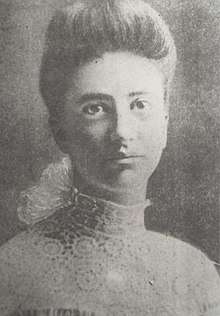Murder of Grace Brown

Grace Mae Brown (March 20, 1886 – July 12, 1906) was an American skirt factory worker whose murder caused a nationwide sensation, and whose life inspired the fictional character Roberta Alden in Theodore Dreiser's novel An American Tragedy as well as Jennifer Donnelly's novel A Northern Light. The facts of the real murder are laid out in the two non-fiction books, both published in 1986: Adirondack Tragedy: The Gillette Murder Case of 1906, written by Joseph W. Brownell and Patricia A. Wawrzaszek, and Murder in the Adirondacks: An American Tragedy Revisited, by Craig Brandon.
Childhood
Brown grew up in South Otselic, New York, the daughter of a successful Chenango County farmer. She was reportedly given the nickname "Billy" because of her love of the contemporary hit song Won't You Come Home Bill Bailey; Brown often signed her love letters "The Kid" after the Western outlaw Billy the Kid. She attended grammar school in the village, and became close friends with teacher Maud Kenyon Crumb and her husband. In 1904, she moved to nearby Cortland to live with a married sister, and went to work at the Gillette Skirt Company.[1]
Romance
Chester Gillette, the company owner's nephew, moved to Cortland in 1905, and began a romantic and sexual relationship with Brown. In Spring 1906, Brown became pregnant, and she returned to her parents in South Otselic. Gillette agreed to take her away to the Adirondacks, apparently promising marriage. Because Brown packed her entire wardrobe for the trip and Gillette packed just a small suitcase, some 21st-century historians conjecture that Gillette had promised to take Brown to a maternity home in upstate New York. Gillette and Brown stayed for a night in Utica, New York, and then continued by train to Tupper Lake in Franklin County, spending the night. Rain the next day ruined their plans for a outing on a nearby lake, so they returned south again by train to Big Moose Lake in Herkimer County, New York.[2]
Murder
On July 11, the couple were seen rowing out on Big Moose Lake near Covewood Lodge. Gillette had entered the pseudonym "Carl Grahm" in the hotel register (Gillette's suitcase was monogrammed "C.E.G.", and he was careful to choose a name with the same initials). Gillette is believed to have struck Brown over the head with a tennis racket, and she fell out of the boat and drowned. Gillette returned alone, and gave varying explanations for what had occurred.[3] Brown's body was found the next day, and Gillette was arrested in the nearby town of Inlet, New York. The defense at trial claimed that Grace was perplexed, and just jumped out of the boat and into the water, despite being fully clothed. Gillette testified, "We talked a little more, then she got up and jumped in the water, just jumped in."[4]
Love letters
In Gillette's rented room, authorities confiscated Brown's love letters to Gillette as evidence. District attorney George Ward read the letters aloud to the court during the trial in the fall of 1906, and Brown's letters gave the trial national attention. Brown pleaded with Gillette in the letters to accept responsibility for her pregnancy. In her final letter, written July 5, Brown looked forward to her impending Adirondack trip with Gillette, and she said farewell to her childhood home of South Otselic, wishing she could confess her pregnancy to her mother: "I know I shall never see any of them again. And mamma! Great heavens, how I do love Mamma! I don't know what I shall do without her (...) Sometimes I think if I could tell mamma, but I can't. She has trouble enough as it is, and I couldn't break her heart like that. If I come back dead, perhaps if she does not know, she won't be angry with me."[5]
Copies of Brown's love letters were published in booklet form, and even sold outside the courtroom during the trial. Theodore Dreiser paraphrased many of the actual letters in An American Tragedy, quoting the final letter almost verbatim. Jennifer Donnelly used many of the actual letters in A Northern Light. Letters written between the two, as well as the diary of Gillette, have been donated to Hamilton College.
The trial
The trial lasted three weeks, and resulted in a guilty verdict and a death sentence. The New York Court of Appeals affirmed the judgement, and Governor Charles Evans Hughes refused to grant clemency.[6]
Gillette was executed on March 30, 1908 in Auburn Correctional Facility by electrocution.[7]
Works
- Donnelly, Jennifer: A Northern Light; London, United Kingdom, Bloomsbury Publishing, Plc, 2003.
- Brandon, Craig: Murder in the Adirondacks; Utica, New York; North Country Books, Inc., 1986, 1995.
- Brownell, Joseph and Wawrzaszek, Patricia: Adirondack Tragedy; Interlaken, New York; Heart of the Lakes Publishing, 1986.
- Thompson, Herold W. Body, Boots and Britches; Cantry, New York; Syracuse University Press, 1939, 1967.
A Place in the Sun is a 1951 American drama film based on the 1925 novel An American Tragedy by Theodore Dreiser
Television
- Murder on Big Moose? Director; Linda Marie Randulfe, Producer, reporter, and writer; Rochelle Cassella; Public Broadcasting Council of CNY, 1988.
- Unsolved Mysteries: Executive producer Terry Dunn Meurer and John Cosgrove, NBC Broadcasting, 1996.
Opera
An American Tragedy: Tobias Picker; 2005 opera premiered in the Lincoln Center.
References
- ↑ ovcs.org -Retrieved 2011-02-18 Archived July 27, 2011, at the Wayback Machine.
- ↑ "Herkimer County Courthouse and the Trial That Inspired "An American Tragedy" by Theodore Dreiser". UCS Benchmarks. New York State Unified Court System. 2006. Retrieved 27 March 2013.
- ↑ Staff report (July 14, 1906). Mystery in Girl's Death: Body Found in Adirondack Lake -- Man Companion Missing. New York Times
- ↑ Grace Brown a suicide, says Gillette at trial New York Times, originally published: November 29, 1906; nytimes.com -Retrieved 2011-02-18
- ↑ Grace Brown's letters stir audience to tears
- ↑ "Clemency Denied" (PDF). Retrieved 2011-02-18.
- ↑ Brandon, Craig (2006). "Murder in the Adirondacks". Retrieved 2011-02-18.